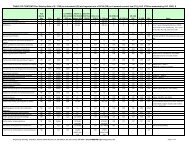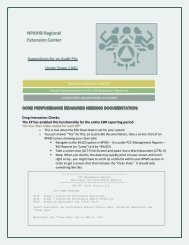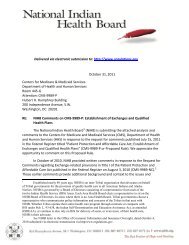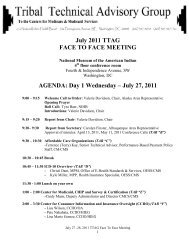âHealth Insurance Premium Tax Creditâ (IRS REG-131491-10)
âHealth Insurance Premium Tax Creditâ (IRS REG-131491-10)
âHealth Insurance Premium Tax Creditâ (IRS REG-131491-10)
- No tags were found...
Create successful ePaper yourself
Turn your PDF publications into a flip-book with our unique Google optimized e-Paper software.
NIHB Supplemental Submission - Definition of Indian―[I]f the statute is silent or ambiguous with respect to the specific question, theissue for the court is whether the agency‘s answer is based on a permissibleconstruction of the statute.‖ 90Under this analysis, the present question is whether (a) Congress clearly expressed itsintent as to who should benefit from the Indian-specific provisions in the ACA and, if not, (b)whether it would be reasonable for HHS to adopt regulations that more specifically identifywho is an ―Indian‖ in its implementing regulations. As discussed below, that answer to thefirst question is ―no,‖ and is ―yes‖ To the second question. In this circumstance, an agency isjustified in adopting regulations.As noted earlier, HHS officials have suggested that HHS may not adopt the definitionin § 447.50 promulgated under ARRA for the purposes of the ACA because the agency‘sregulatory authority under ACA is different than under ARRA. They note that ARRA didnot specifically define ―Indian‖ and suggest that the Snyder Act of 1921 91 authorized HHS tocraft the definition in § 447.50 to fill in the gap left by the statute. By comparison, theseofficials worry that Congress‘s inclusion of statutory definitions of ―Indian‖ in the ACA doesnot leave room for administrative interpretation, and that only Congress may reconcile theACA‘s multiple definitions of the term.However, as discussed below (and in Section 3.2 of this Analysis and Comment), theSnyder Act is the primary statute authorizing the Federal government to provide health careto Indians and implementing the unique Federal obligations to Indians. Therefore, theSnyder Act applies with equal force to the ACA as it does to ARRA, and therefore CMS isempowered and obligated to supply a uniform definition of ―Indian‖ for the latter statute justas it did under ARRA. 92Several cases have held that when Federal agencies draft eligibility regulations forprograms under the Snyder Act, because they are ―for the ‗special benefit‘ of all Indians[,]any ambiguities should be resolved in favor of inclusion‖ with regard to eligibility. 93 Onesuch court favorably pointed to the IHCIA‘s 1998 inclusion of California Indians as anexample of this principle. 94 This is consistent with the Indian canons of construction, whichrequire that ambiguities in the interpretation of treaties, statutes, regulations and othergovernmental-tribal agreements be construed in favor of the Indians, 95 and all ―doubtfulexpressions [be given] that meaning least prejudicial to the interests of the Indians.‖ 9690919293Id. at 842–843.P.L. 67-85, 42 Stat. 208, codified as amended at 25 U.S.C. 13.Also see, § 3 of the Transfer Act.Malone v. Bureau of Indian Affairs, 38 F.3d 433, 438 (9th Cir. 1994); accord Zarr v. Barlow,800 F.2d 1484, 1493 (9th Cir. 1986). In fairness, it should be noted that the Malone court overturnedthe BIA regulations at issue for violations of the federal Administrative Procedure Act. This does notdetract from or otherwise diminish the validity of the case‘s interpretation of the Snyder Act.9495Malone, 38 F.3d at 438.See, e.g., Yakima v. Confederated Tribes and Bands of the Yakima Indian Nation, 502 U.S.251, 269 (1992) (―When we are faced with these two possible constructions, our choice between themNational Indian Health Board Page 21 of 24 October 31, 2011










